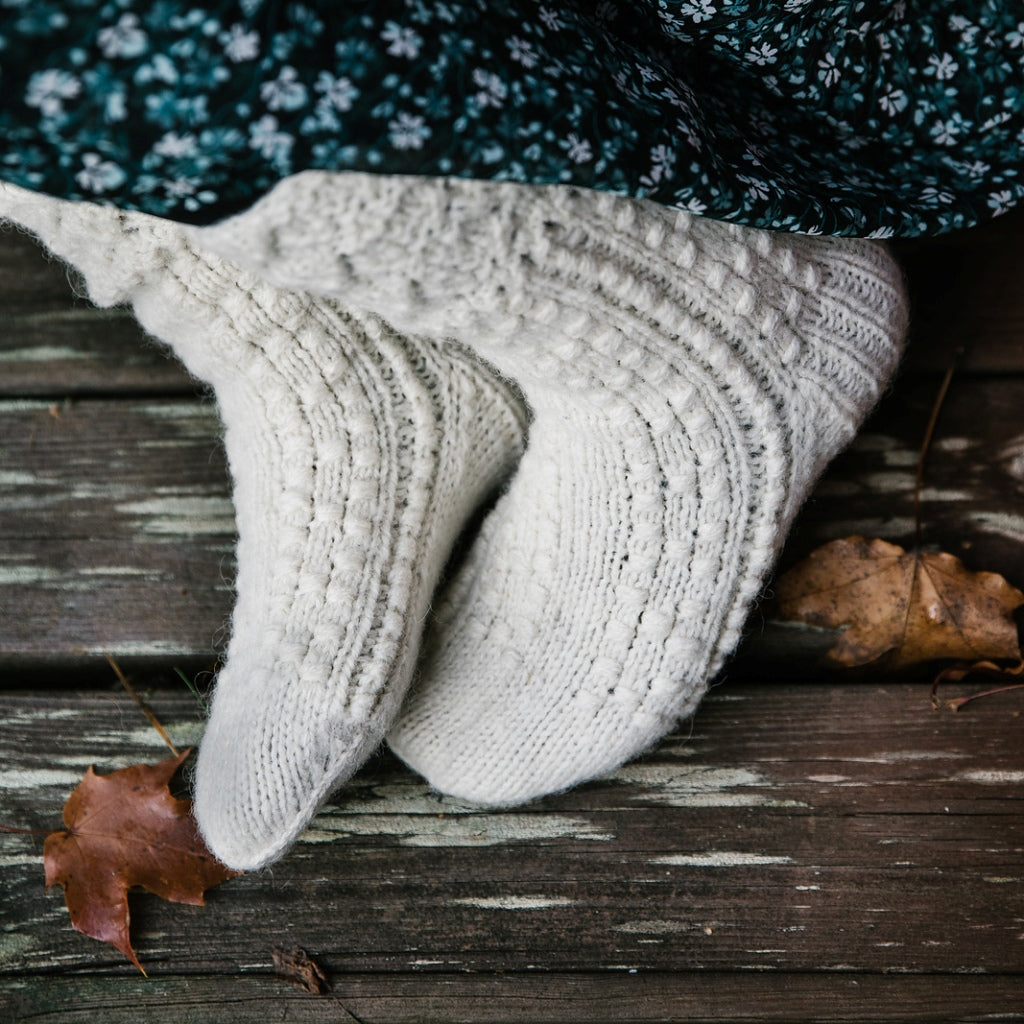February saw the release of Laine Publishing’s beautiful new book, 52 Weeks of Socks. Our first and second batches both sold out very quickly, but we are happy to announce that Laine has commissioned one final print run and we are now expecting more stock in mid-April. So I would like to use this opportunity to talk a little bit about sock-knitting, and sock yarn.
As you know, here at Laine des Iles, we don’t sell superwash yarns. We do sell Tukuwool Sock, which contains nylon, however ultimately we would prefer to carry only completely natural yarns with no synthetic fibres at all. Many knitters would assume that this means they wouldn’t be able to knit socks with our yarns. But of course this isn’t true, and we’d like to share the thoughts of designer Albina McLaughlin about knitting socks with all-natural yarns. The following excerpt is taken from an article published on Albina’s blog in November 2018:
Some of my first memories from childhood, are of my grandmother knitting socks. She used steel double-pointed needles, which seemed to move in her hands at the speed of light, while her ball of yarn likewise swiftly diminished. The yarn she used was usually whatever was left over from larger projects, such as sweaters. It was roughly sportweight equivalent in weight, and always 100% wool. No superwash treatment. No nylon. The socks lasted for years.
It is perhaps for this reason, that the concept of sock yarn has always amused me, as have the occasional startled reactions to my “inappropriate” sock-knitting yarn choices. It has been the dominant narrative in the knitting industry for some time, that sock yarn should contain nylon and be superwash-treated. The reasons being, that both of these features make the socks more hard-wearing, and that, in addition, the nylon content facilitates stretch. The argument, however, never rang quite true to me. By all accounts, socks were plenty hard-wearing before the widespread use of nylon and the invention of superwash (one older friend describes socks lasting so long in her family, they were passed down from one sibling to the next!). Also, as a fibre that is inherently elastic in its own right, wool should not really need synthetic help in that regard.
Still, around two years ago I decided to keep an open mind and give “sock yarn” an honest try. Which I did, making pair after pair out of the usual suspects - including commercial yarns from several big brands, and hand-dyed yarns using various merino/nylon and BFL-nylon blends. At the same time, I continued to knit socks out of various “non sock” yarns.
And?
According to my experience with the socks I wear myself, and to feedback from others who wear the socks I make, my impression is that it makes no difference. The main factor determining how hard-wearing a sock will be, seems to be the tension it is knitted at. Knit a sock densely, and it will wear wonderfully - superwash or not, nylon or not. Loosen up on the tension, and it will not.
I can show you socks that are superwash treated and 25% nylon, which felted grotesquely at the heels after their 2nd or 3rd outing. And I can show you socks that are 100% non-superwash wool, which look nearly new after a year of regular wear. A difference of even 1 stitch per 10cm in tension seems to play a larger role in a sock’s durability, than the presence or absence of nylon content and superwash treatment. The superwash, nylon-blend socks are not worse. But neither are they better.
Of course, the above is just my experience. And if it contradicts yours, by no means do I want to dismiss that. But considering that my experience has been as described, I have decided at this stage to go back to using yarns that are 100% natural fibres, and minimally processed (no superwash). Even for socks.
![[english]](http://cdn.shopify.com/s/files/1/0977/1950/files/Berry_Lane_3_large.jpg?v=1583774091)
Albina has herself designed a sock pattern specifically intended for knitting with non-superwash, no-nylon yarn (Berry Lane, pictured above), and 52 Weeks of Socks also features a number of patterns knitted with all-natural yarns (for example Veera knitted in Ullcentrum 2-Ply, pictured at the top of the page). So we hope this will give you the courage to leave the nylon behind and try all-natural socks!
Albina McLaughlin (Ailbíona McLochlainn in Gaelic) is a handknit designer based in County Donegal in the Republic of Ireland. Her preference is to work with natural fibres and with locally sourced yarns wherever possible. You can find her on Ravelry as LB Handknits or on Instagram as @lbhandknits. Do check out more of her beautiful designs.



